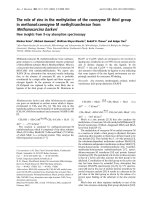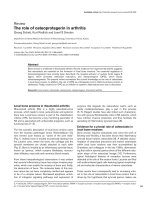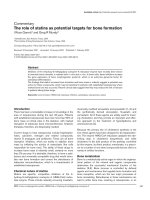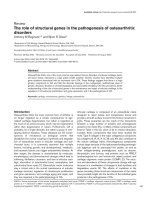Báo cáo y học: "The role of emergency medicine physicians in trauma care in North America: evolution of a specialty" pps
Bạn đang xem bản rút gọn của tài liệu. Xem và tải ngay bản đầy đủ của tài liệu tại đây (196.8 KB, 6 trang )
BioMed Central
Page 1 of 6
(page number not for citation purposes)
Scandinavian Journal of Trauma,
Resuscitation and Emergency Medicine
Open Access
Review
The role of emergency medicine physicians in trauma care in North
America: evolution of a specialty
Michael D Grossman
Address: St. Luke's Hospital, Trauma and Surgical Critical Care, Estes Surgical Group 801 Ostrum Street, Bethlehem, PA 18015, USA
Email: Michael D Grossman -
Abstract
The role of Emergency Medicine Physicians (EMP) in the care of trauma patients in North America
has evolved since the advent of the specialty in the late 1980's. The evolution of this role in the
context of the overall demands of the specialty and accreditation requirements of North American
trauma centers will be discussed. Limited available data published in the literature examining the
role of EMP's in trauma care will be reviewed with respect to its implications for an expanded role
for EMPs in trauma care. Two training models currently in the early stages of development have
been proposed to address needs for increased manpower in trauma and the critical care of trauma
patients. The available information regarding these models will be reviewed along with the
implications for improving the care of trauma patients in both Europe and North America.
Introduction
The role of Emergency Physicians (EMP) in the care of
trauma patients varies considerably depending upon
locale, available expertise and presence or absence of reg-
ulatory agencies. This review attempts to define some of
these variables and suggests alternative models based
upon existing needs and resource availability. Much of the
discussion is centered on the North American experience
that has evolved over the past forty years. There may be
certain features applicable to European systems which
themselves have significant variability between countries.
A fundamental assumption underlying this review is that
there should be measurable standards of care for trauma
patients and that these will include some degree of exper-
tise and perhaps even specialization in trauma care. This
field has come to be known in the US as "Traumatology"
in distinction to Trauma Surgery. Whether expertise in
Traumatology is the province of surgeons, EMP's, or other
physicians remains a matter of discussion in North Amer-
ica and there is little data available addressing the ques-
tion. Similarly, training models for EMPs that are in place
in Europe differ from those in the US and thus the relative
skill sets with respect to trauma care are difficult to com-
pare. Newer models in North America that emphasize
advanced training in trauma and critical care for EMP's are
just being developed and have not been well studied.
Workflow considerations
Emergency department (ED) workflow is governed by
patient volume and staffing. Busy ED's in North America
may see more than 100,000 patients per year and there-
fore several hundred visits per-day. Data regarding vol-
ume per provider may vary depending on staffing patterns
but generally should not exceed 2–3 patients per provider
per hour [1]. In busy ED's this goal may be difficult to
achieve. There is considerable literature dealing with the
subject of overcrowding and its causes [2,3]. Most authors
agree that a significant percentage of ED volume consists
of low-acuity "walk-in" disease that has increased as pri-
mary care networks become more difficult to access, and
Published: 23 August 2009
Scandinavian Journal of Trauma, Resuscitation and Emergency Medicine 2009, 17:37 doi:10.1186/1757-7241-17-37
Received: 14 May 2009
Accepted: 23 August 2009
This article is available from: />© 2009 Grossman; licensee BioMed Central Ltd.
This is an Open Access article distributed under the terms of the Creative Commons Attribution License ( />),
which permits unrestricted use, distribution, and reproduction in any medium, provided the original work is properly cited.
Scandinavian Journal of Trauma, Resuscitation and Emergency Medicine 2009, 17:37 />Page 2 of 6
(page number not for citation purposes)
while the overall affect of low acuity patients on over-
crowding is thought to be nominal [2,3], it may impact
physician work flow. In addition, in many Emergency
Departments in the US, the EMP serves a gatekeeper func-
tion with responsibility for the initial phase of care for all
acute care emergencies admitted to the hospital. Recent
data indicates that an increasing percentage of all hospital
admissions (18–25%) in the US come through the ED,
thus patients may be "held" in the ED awaiting admission
but in many cases must still be cared for by EMP's. Finally,
in some hospitals, EMP's are required to leave the ED in
order to respond to hospital emergencies as members of a
code or rapid response team further affecting prioritiza-
tion and work flow considerations.
All these factors impact work flow for the EMP. Since most
major trauma centers in North America are associated
with busy ED's the added burden of managing complex
trauma patients is a consideration affecting the involve-
ment of all ED staff including physicians. The American
College of Surgeons Committee on Trauma (ACSCOT)
handbook on optimal care of the injured patient specifi-
cally states that "The Emergency physician may be
assigned control [of the trauma patient] until the surgeon
arrives" Since the expectation is that a surgeon will
respond within five minutes in Level I and II trauma cent-
ers, participation by the EMP beyond that time period is
not required, at least by ACSCOT standards [4]. Those
standards go on to describe that following arrival of the
surgeon; performance of diagnostic and therapeutic pro-
cedures will be "shared in accordance with mutually
agreed upon protocols". Data published more than ten
years ago demonstrate that the average time per-patient
required to care for all blunt trauma patients is approxi-
mately one hour per patient and that severely injured
patients may require 6–8 hours of continuous care [5].
Thus the overall impact of caring for trauma patients on
work flow considerations in US ED's may vary considera-
bly depending on the role of the EMP relative to the
trauma team.
Current models of trauma care in the US frequently utilize
an approach that brings the trauma team to the ED, often
in a somewhat separate physical space, and usually
involves the EMP for some phase of resuscitation, then
returns the EMP to the department. This appears to be
least disruptive to work flow in large departments with
busy trauma centers. In Canada where EMP's, Anesthesi-
ologists or Surgeons may function as trauma team leaders,
the Trauma Association of Canada still requires that
trauma call covered by EMP's must be kept separate from
general ED duties so that there are no conflicts between
ED work flow and trauma care [6,7].
In ED's with lower volumes, workflow patterns may be
more favorable with respect to the competing priorities
described above. However, these ED's may be associated
with hospitals that do not possess the specialty care
required for trauma patients after the resuscitative phase
of care is completed. In the US, EMP's in these lower vol-
ume departments may be more likely to perform initial
resuscitative care and transport the patient to a trauma
center. EMP's therefore may play a significant role in the
initial phase of trauma care as part of their overall work
flow in many US hospitals that are not trauma centers.
The timeliness and adequacy of care by EMP's under these
circumstances is most often not well monitored since
trauma care in these hospitalized is not necessarily scruti-
nized by ACSCOT trauma center accreditation standards.
Historic considerations: US model for trauma
care
The concept of regionalized civilian trauma networks in
the United States dates back at least to the late 19
th
century
when William Estes created a system of care for injured
railroad workers and miners in Northeast Pennsylvania
[8]. The formation of a committee to study outcomes in
fracture management of which Dr Estes was a founding
member gave rise to what would become the American
College of Surgeons Committee on Trauma (ACS-COT).
Beginning with the study by Zollinger in 1955, a number
of publications over the next 30 years examined the con-
cept of preventable trauma deaths [9-12]. Several land-
mark studies related preventable deaths to hospital size
(defined as "hospital category") and the presence or
absence of a regional trauma hospital [13-15]. Reacting at
least in part to data provided by these studies the ACSCOT
initially published guidelines for staffing and organizing a
"Trauma Center" in 1976 [4]. This publication has under-
gone multiple revisions and re-editions but remains the
standard document describing the resources required for
optimal care of trauma patients.
As early as 1966 the role of physicians staffing emergency
rooms in the care of trauma patients was discussed as an
important element in preventable trauma death [16]. The
publication by Lowe et al in 1983 documented specific
opportunities for improvement in preventable trauma
death that were related to timeliness of care and appropri-
ate diagnosis and treatment provided by emergency
rooms in hospitals in the state of Oregon [17].
The impetus to develop a specialty of emergency medicine
in the US was driven in part by issues related to emergency
care for trauma patients [10,16-19]. Generalists or family
physicians staffed North American ED's and specialists
were called to manage and admit patients according to
need. In this regard, North American ED's of the 1960's
and 1970's resembled current practice in some European
countries. Based in large part upon the sentinel study pub-
lished in 1966 the ACSCOT supported the concept of spe-
Scandinavian Journal of Trauma, Resuscitation and Emergency Medicine 2009, 17:37 />Page 3 of 6
(page number not for citation purposes)
cialized physicians with training in Emergency Medicine
but maintained the primary role of surgeons as "captain of
the ship" in trauma care [4,16]. Current standards for
Level I trauma center accreditation in the US require 24
hour emergency room coverage by a trained EMP and
immediate availability of surgeons who must be present
within 5 minutes of the arrival of the trauma patient.
The degree to which surgeons and EMP's interact in the
care of trauma patients and the specific clinical roles of
each provider is addressed by the ACSCOT and is depend-
ent upon the level or complexity of the trauma center. As
noted previously, for trauma centers with level I or II des-
ignations, a surgeon must be immediately available with
full time EM staff assigned control of the trauma patient
until the surgeon arrives. In addition, the standards for
optimum care describe specific physiologic, anatomic and
mechanistic criteria that should mandate the highest level
of trauma response within a trauma center that would
require the surgeon to be present.
Challenges to the exisiting model for optimum
care of the trauma patient
From its inception there have been numerous challenges
to implementation of the standards for optimal care of the
trauma patient. Trunkey and West identified these issues
30 years ago commenting that " staffing requirements
are stringent and for the most part can only be met in a
large university teaching hospital with house staff" [15].
In addition, the standards do not address the larger issue
of whether or not hospitals may choose to participate in a
state or regional trauma system. Thus in many regions of
the US patients may be delivered to a hospital that does
not participate in a trauma system and therefore may not
possess the resources for optimal care.
Even within the established, well-developed trauma net-
works present in large urban and suburban centers within
the US and Canada there are many challenges to provid-
ing optimal trauma care. It is because of these issues that
new and different roles for EMPs in trauma care have been
suggested. Examples of challenges to the ideal model envi-
sioned by the ACS-COT include an overall decline in sur-
gical manpower, a declining interest among surgeons in
providing trauma care, and a shift in access patterns for
health care that has placed increasing burdens on emer-
gency departments and availability of specialists to cover
emergency call [20-25].
Optimal care of trauma patients involves more than the
resuscitative phase of care carried out in the emergency
department and includes critical care, surgical specialty
care, rehabilitation and follow-up. Additional challenges
exist in several of these areas; those that involve the ICU
phase of care may affect the role of EMP's in trauma care
[26,27]. Recent publications have cited inconsistencies
between ASCOT standards for participation of trauma sur-
geons in the critical care of trauma patients and the reali-
ties of practice in US trauma centers [27]. Lack of
manpower among Surgical Intensivists/Trauma Surgeons
has resulted in the increased use of non-surgeon intensiv-
ists including EMP's who have received additional train-
ing in critical care [26]. This environment more closely
resembles models in place in Europe where non-surgeon
intensivists are the most common care providers for
trauma patients in the ICU.
Role of EMP'S in trauma care
The role of EMP's in trauma care in North America varies
considerably and is dependent upon whether or not the
ED is associated with a trauma center, the level of trauma
center designation, the presence or absence of regulatory
guidelines and the nature of those guidelines. In addition,
the presence or absence of surgical back-up, critical care
resources and surgical specialty care will affect the hospi-
tals' ability to care for trauma patients and therefore the
role of EMP's. Finally, EMP training and experience will
affect willingness and ability to care for trauma patients.
Residency training in Emergency Medicine in the US
requires a minimum of 36 months of training in an
accredited residency. Training must include the perform-
ance of 35 adult trauma resuscitations but there is no pro-
vision for determining how the resident will be assured a
role as team leader in those resuscitations. Two months of
dedicated critical care on a separate inpatient service are
also required. There is no requirement for rotation on a
trauma service [28]. There might be considerable varia-
tion in training with some programs including 2–3
months of rotations on a trauma service and/or separate
critical care rotations. Residents from these programs
might have a higher comfort level with trauma care than
those whose training allows exposure to trauma only as
part of their general EM training, particularly if a separate
trauma team responds for trauma activations.
In smaller North American hospitals that are not desig-
nated as trauma centers the first, and often the only phy-
sician responder for trauma patients will be most likely an
EMP. Though no formal data exist it is likely that many of
these hospitals where care is rendered exclusively by EMPs
are smaller hospitals with limited surgical capability and
fewer ED visits where the arrival of a trauma patient is
likely to be less disruptive to the overall function of the
Emergency Department. In an organized regional trauma
system any seriously injured patient would most likely be
transferred to the nearest trauma center. In this regard the
US may differ from European and even Canadian systems
where smaller community or regional hospitals might
participate equally in trauma care.
Scandinavian Journal of Trauma, Resuscitation and Emergency Medicine 2009, 17:37 />Page 4 of 6
(page number not for citation purposes)
EMP's may also see trauma patients in larger hospitals not
designated as trauma centers, with or without formalized
trauma systems, but where surgical back-up, surgical spe-
cialty care and critical care services are available. There is
little if any published data examining this phenomenon
though some conclusions might be drawn from the study
by MacKensie et al compared outcomes for trauma
patients admitted to trauma centers vs. non trauma center
hospitals [29,30]. These non-trauma center hospitals aver-
aged more than 200 acute care beds and 19 critical care
beds. In this study, 34% of non-trauma center hospitals
utilized a trauma team while 66% did not. Thirty-per cent
of non-trauma centers utilized in-house surgeons, 70%
did not. In this setting it is reasonable to assume that
EMP's might evaluate and treat trauma patients but gener-
ally require surgical support to admit patients with more
serious injuries. Though not specifically supported by the
published data, in non-trauma center hospitals lacking
formalized trauma admission protocols, EMP's might
find that general surgeons and surgical specialists are
unwilling to admit patients or accept responsibility for
"non-surgical" problems or injuries not in their "body
region". Particularly in busy ED's these barriers to admis-
sion and disposition become a significant problem for
EMP's and a disincentive to participate in trauma care. In
some cases EMP's may resort to admitting patients to
medical services despite the perceived lack of expertise of
those services in managing trauma patients. This practice
is perceived as suboptimal care for a trauma patient with
serious injuries but again has not been subjected to objec-
tive outcome analysis.
Within designated trauma centers in North America the
role of EMPs varies considerably depending upon level of
trauma center and practice pattern. New roles for EMPs
are being defined and studied.
For the most part, in busy trauma centers in the US, EMP's
function as members of a trauma team and participate in
accordance with ASCOT guidelines. For patients meeting
criteria for the highest level of trauma team activation a
surgeon must be present and generally acts or is expected
to act as the team leader. EMP's often function as the air-
way manager and/or in other capacities as designated by
the team leader (3). These guidelines have implications
for training of EM residents who may not have the oppor-
tunity to acquire team leadership skills in trauma resusci-
tation. The requirement that surgeons need to present
during trauma activations has been questioned [7,18,31-
33].
Within trauma centers there has been consistent interest
in designating more than one level of trauma response
[34-38]. These efforts have focused upon the implications
of the inherent over triage of trauma patients in trauma
centers and have utilized EMP's to evaluate and manage
those patients. These studies focused upon the impact of
over triage on already burdened systems, the cost of full
trauma-team activation, and the comparable patient
safety achieved using two tiers of trauma response. Inter-
estingly, whether a tiered system is present or not, a pro-
portion of all trauma patients evaluated in any trauma
outcome study will be comprised of patients whose eval-
uation was carried out by EMP's. Discovery of injuries
and/or co-morbidities requiring admission will lead to
consultation from an admitting trauma service. While this
process of care is scrutinized by most well developed
trauma program performance improvement programs,
the results have not been widely reported in the literature.
Virtually all the literature dealing with tiered response
reports that triage tools accurately sort patients into low
and high acuity groups but there is less detailed evidence
regarding process and outcome for severely injured
patients inadvertently evaluated in the lower tiered group
[34-38]. Examples might include isolated closed head
injury or solid organ injury.
Within the past five years several reports have been pub-
lished in Canada and the USA suggesting that the presence
of a surgeon at both adult and pediatric trauma resuscita-
tions is superfluous [7,31-33]. Most of these reports
describe the role of the EMP in team leadership during the
resuscitative phase of care. Following this ED or resuscita-
tive phase of care, presumably these patients would be
admitted to a surgical or trauma service. All the studies ref-
erenced report comparable survival based upon the
involvement of EMP's during the resuscitation time frame.
There has been criticism that these studies suffer from
methodological flaws including but not limited to being
under powered and containing too few penetrating
trauma patients [39]. Nonetheless, these studies serve to
quantify what has long been assumed; EMP's can evaluate
and treat patients with minor injuries and are able to
effectively "team lead" resuscitations for patients with
more serious injuries. Whether surgeons should be
present in a mandatory or selective fashion remains open
to debate but mandatory presence remains standard of
care in the US. Selective surgical presence has been vali-
dated in Canadian trauma centers where surgical team-
leaders are not required [7].
The role of the EMP and the question of expertise in major
trauma involving complex decision-making beyond the
resuscitative phase of care is less well established by these
studies. These components or service elements include
but are not limited to coordination of competing clinical
priorities such as those related to concomitant neurosur-
gical and orthopedic emergencies, critical care issues, and
diagnosis and treatment of complex problems such as
actively bleeding pelvic fractures, high-grade solid organ
injury complexes, and major chest trauma.
Scandinavian Journal of Trauma, Resuscitation and Emergency Medicine 2009, 17:37 />Page 5 of 6
(page number not for citation purposes)
Advanced Training Models
Recent publication of data from our group focuses upon
the process of advanced training and practice in trauma-
tology by EMP's [40]. The concept of providing fellowship
training in Trauma/Critical Care to EMP's is not new.
European EMP's may pursue advanced training in Critical
Care leading to a specialty board exam. The role of these
physicians in trauma care is not well known. In US and
Canadian trauma centers this is a relatively new training
model but some large centers have used EMP Traumatol-
ogists as attending staff and reported favorable results
(personal communication). The study by Grossman is the
first we know of to report objective data defining process
and outcome during the first 24 hours of care [40]. A sin-
gle fellowship-trained EMP was compared to a group of
fellowship-trained Trauma Surgeons. The EMP had
trauma surgical back-up available but treated patients
independently including driving the decision making
process for management of multiple complex injuries
after admission to the ICU. The provider groups were sim-
ilar with respect to several process variables including test
ordering, blood transfusion, frequency and severity of
patients admitted to ICU. Time to operating room, missed
injury and delay in diagnosis were also similar. While this
study has many limitations it is the first to evaluate the
performance of EMP's who have undergone fellowship
training and it examines aspects of care beyond the ED.
EMP's who have received advanced training in Critical
Care participate as intensivists managing trauma patients
in several large US trauma centers [26,27]. Direct compar-
ison between EMP's and other non-surgical intensivists in
the care of trauma patients have not been published to the
best of our knowledge. Despite the fact that EMP's who
receive advanced training in critical care with or without
advanced training in traumatology cannot currently be
certified by any US specialty board, some of these physi-
cians have taken the European board exams and utilized
their results for credentialing in US hospitals. A novel
approach for certification in critical care in the US is addi-
tional training in Neuro-intensive care that leads to a cer-
tificate of added qualifications offered by the American
Board of Medical Specialties.
Conclusion
The role of EMP's in Trauma care in North America differs
considerably from European systems. Trauma care in the
US is highly regionalized and has been organized around
a surgical model the validity of which has been called into
to question by a number of publications in the Emergency
Medicine literature (multiple). While there is controversy
regarding some of these studies it does seem clear that the
current system of care in the US provides effective care for
trauma patients. It is equally clear that the system may not
be sustainable or desirable in it's current form and in this
regard EMP's are likely to have an expanded role in
trauma care.
While not proven by objective data it is clear that effective
trauma care is a continuum including but not limited to
care rendered in the ED. Expertise in trauma care requires
understanding of all phases of care whether practiced by
Surgeons EMP's or other non-surgeons. Advanced training
models for EMP's might allow increased effectiveness of
care both inside the ED and beyond it.
Competing interests
The author declares that they have no competing interests.
References
1. Counselman FL, Marco CA, Patrick VC, McKenzie DA, Monck L,
Blum FC, Borg K, Coppola M, Gerard WA, Jorgenson C, Lazarus J,
Moorhead J, Proctor J, Schmitz GR, Schneider SM: A study of the
workforce in emergency medicine: 2007. Amer Journ of Em Med-
icine 2009, 27:691-700.
2. Bernstein SL, Asplin BR: Emergency Department Crowding:
Old Problem New Solutions. Em Med Clin NA Nove 2006, 24(4):.
3. Hoot NR, Aronsky D: Systematic review of Emergency
Department crowding: Causes, effects and solutions. Ann Em
Med 2008, 52(2):.
4. Committee on Trauma, American College of Surgeons.
Resources for Optimal Care of the Injured Patient 2006.
5. Grossman MD, Schwab CW, Chu-Rodgers S, Kestner M: Time and
motion: a study of trauma surgeons' work at the bedside
during the first 24 hours of blunt trauma care. J Trauma 1999,
46:757-763. discussion 763–754
6. The Trauma Association of Canada: Trauma System Accredita-
tion Guidelines. Toronto, Canada: Trauma Association of Canada;
2003.
7. Ahmed JM, Tallon JM, Petrie DA: Trauma management out-
comes associated with nonsurgeon versus surgeon trauma
team leaders. Ann Emerg Med 2007, 50:7-12.
8. Fitts WT Jr: Memoir of William Lawrence Estes, Jr., 1885–
1971. Trans Stud Coll Physicians Phila 1972, 40(2):137-8.
9. Zollinger RW: Traffic Injuries: A Surgical Problem. AMA Arch
Surg 1955, 70(5):694-700.
10. Boyd DR, Cowley RA: Systems approach to the care of the trauma
patient Volume Chapter 19. Edited by: Boyed DR, Edlich RF, Milde SH.
Conn., Appelton- Century, Crafts; 1983.
11. West JG, Gazzanigan AB, Calen RH, (eds): Trauma Care Systems:
Clinical, Financial and Political Considerations. New York,
Praeger Publishers; 1983.
12. Calen RH, Hellig RW Jr, (eds): Trauma Care Systems. Rockville,
MD, Aspen Systems Corp.
13. Bruser DM: Emergency care of auto crash victims. In Proceed-
ings of the 11th annual meeting of the American Association for automotive
medicine Edited by: Keeney AH. Springfield Ill, Charles C Thomas Pub-
lisher; 1970:232-239.
14. Moylan JA, Detman DE, Rose J, Schulz R: Evaluation of the quality
of hospital care for major trauma.
J Trauma 1976, 16:517-528.
15. West JG, Trunkey DD, Lim RC: Systems of Trauma Care: A
Study of Two Counties. Arch Surgery 1979, 114:455-60.
16. Accidental Death and Disability: The Neglected Disease of
Modern Society. Washington, DC, National Academy of Sciences/
National Research Council; 1966.
17. Lowe DK, Gately HL, Goss JR, Frey CL, Peterson CG: Patterns of
death, duplication and error in the management of motor
vehicle accident victims: Implications for a regional system
of care. J Trauma 1983, 23:503-509.
18. Green JM: Trauma Surgery: Discipline in Crisis. Ann Em Med
2009, 53:198-207.
19. American Board of Emergency Medicine website [http://
www.abem.org/PUBLIC/portal/alias__Rainbow/lang__en-US/
tabID__3333/DesktopDefault.aspx]. accessed May 6, 2009
20. Fisher JE: The Impending disappearance of the general sur-
geon. JAMA 2007, 298:2191-2193.
Publish with BioMed Central and every
scientist can read your work free of charge
"BioMed Central will be the most significant development for
disseminating the results of biomedical research in our lifetime."
Sir Paul Nurse, Cancer Research UK
Your research papers will be:
available free of charge to the entire biomedical community
peer reviewed and published immediately upon acceptance
cited in PubMed and archived on PubMed Central
yours — you keep the copyright
Submit your manuscript here:
/>BioMedcentral
Scandinavian Journal of Trauma, Resuscitation and Emergency Medicine 2009, 17:37 />Page 6 of 6
(page number not for citation purposes)
21. Shackford S: How then shall we change? J Trauma 2006, 60:1-7.
22. Schackford SR: The future of trauma surgery – a perspective.
J Trauma 2005, 58:663-667.
23. Esposito TJ, Leon L, Jurkovich GJ: The shape of things to come;
results from a national survey of trauma surgeons on issues
concerning their future. J Trauma 2006, 60:8-16.
24. Rotondo MF, Esposito TJ, Reilly PM, Barie PS, Meredith JW, Eddy VA,
Rabinovici R, Jacobs LM, Cunningham PR, Frykerg ER, Rhodes M, Pas-
quale MD, Enderson BL, Locurto JJ, Atweh NA, Ivatury AA: The
position of the Eastern Association for the Surgery of
Trauma on the future of trauma surgery. J Trauma 2005,
59:77-79.
25. Institute of Medicine. Emergency medical services at the
crossroads. 2006.
26. Kozar RA, Shackford SR, Cocanour CS: Challenges to the Care of
the Critically Ill: Novel Staffing Paradigms. Journal of Trauma
2008, 64:366-373.
27. Nathens AB, Maier RV, Jurkovich GJ, Monary D, Rivara FP: The
Delivery of Critical Care Services in US Trauma Centers: Is
the Standard Being Met? J Trauma 2006, 60:773-784.
28. Guidelines for Residency Training in Emergency Medicine
[ />]. Accessed July,
15, 2009
29. MacKenzie EJ, Rivara FP, Jurkovich GJ, Nathens AB, Frey KP, Egleston
BL, Salkever DS, Scharfstein DO: A national evaluation of the
effect of trauma-center care on mortality. N Engl J Med 2006,
354:366-378.
30. Nathens AB, Jurkovich GJ, Cummings P, Rivara FP, Maier RV: The
effect of organized systems of trauma care on motor vehicle
crash mortality. JAMA 2000, 283(15):1990-4.
31. Steele R, Gill M, Green SM, Parker T, Lam E, Coba V: Do the Amer-
ican College of Surgeons' "Major Resuscitation" Trauma
Triage Criteria Predict Emergency Operative Management?
Annals of Emergency Medicine 2007, 50(1):1-6.
32. Nwomeh BC, Georges AJ, Groner JI, Haley KJ, Hayes JR, Caniano DA:
A leap in faith: the impact of removing the surgeon from the
level II trauma response. Journal of Pediatric Surgery 2006,
41:693-699.
33. Groner JI, Covert J, Lowell WL, Hayes JR, Nwomeh BC, Caniano DA:
The impact of managing moderately injured pediatric
trauma patients without immediate surgeon presence. Jour-
nal of Pediatric Surgery 2007, 40:1026-1030.
34. Hoff WS, Tinkoff GH, Lucke JF, Lehr S: Impact of Minimal Injuries
on a Level I Trauma Center. J Trauma 1992, 33(3):408-412.
35. Phillips JA, Buchman TG: Optimizing Prehospital Triage Crite-
ria for Trauma Team Alerts. J Trauma 1993, 34(3):127-132.
36. Tinkoff GH, O'Connor RE, Fulda GH: Impact of a Two-Tiered
Trauma Response in the Emergency Department: Promot-
ing Efficient Resource Utilization. J Trauma 1996, 41(4):735-40.
37. Terregino CA, Reid JC, Marburger RK, Leipold CG, Ross SE: Sec-
ondary Emergency Department Triage (Supertriage) and
Trauma Team Activation: Effects on Resource Utilization
and Patient Care. J Trauma 1997, 43(1):61-4.
38. Cook CH, Muscarella P, Praba AC, Melvin WS, Martin LC: Reducing
Overtriage Without Compromising Outcomes in Trauma
Patients. Arch Surg 2001,
136:752-756.
39. Pascual J, Sarani B, Schwab CW: American College of Surgeons
Criteria for Surgeon Presence at Initial Trauma Resuscita-
tions: Superfluous or Necessary? Annals of Emergency Medicine
2007, 50(1):15-17.
40. Grossman MD, Portner M, Hoey BA, Stehly CD, Schwab CW, Stoltz-
fus J: Emergency Traumatologists as Partners Trauma Care:
The Future is Now. JACS 2009, 208(4):503-509.









